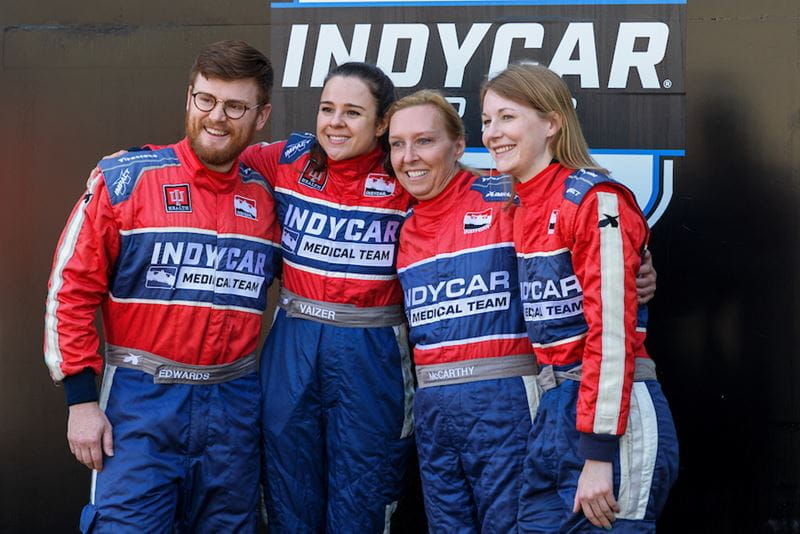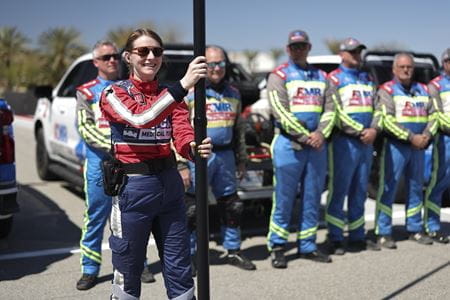From her first Indianapolis 500 at age 5, Elizabeth Sullivan loved the sights, the sounds, the thrill of racing. Today, she’s the fourth person in the world to become a Motorsports Medicine Fellow through a unique program started at the Indiana University School of Medicine.
“I’ve wanted to be a doctor forever, so melding that with motorsports — something I’ve always found to be one of my happy places — is kind of awesome,” said Sullivan, DO, an emergency medicine physician who since July 2024 has been traveling with INDYCAR and working other racing series events at the Indianapolis Motor Speedway.
Growing up in a family of race fans, Sullivan first visited The Brickyard as a toddler. Her family’s priest was an INDYCAR chaplain. As a youth, Sullivan and her cousin went around to all the team garages to collect driver autographs. Tony Kanaan was her favorite.
The only years she’s ever missed the Indy 500 was during COVID, when Sullivan was completing her emergency medicine residency in South Texas — her first time living outside the Hoosier state. In 2021, she hosted a watch party for her co-residents.
“I think I annoyed the crap out of the people I worked with because I’m an Indiana girl at heart, and I was constantly spouting off about how Indiana was a better state,” Sullivan said.
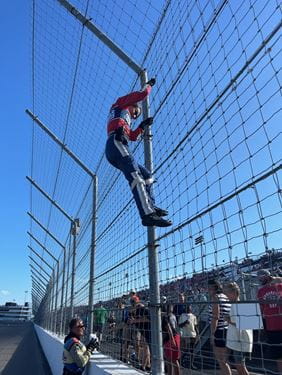 So, when her residency director heard about a brand-new Motorsports Medicine Fellowship at IU, she knew Sullivan would be a perfect fit. The next day, Sullivan was on the phone with Julia Vaizer, MD, the program's first graduate and INDYCAR’s first female medical director. By the end of a two-hour call, Vaizer had invited Sullivan to come to Indianapolis for the month of May.
So, when her residency director heard about a brand-new Motorsports Medicine Fellowship at IU, she knew Sullivan would be a perfect fit. The next day, Sullivan was on the phone with Julia Vaizer, MD, the program's first graduate and INDYCAR’s first female medical director. By the end of a two-hour call, Vaizer had invited Sullivan to come to Indianapolis for the month of May.
Sullivan experienced the thrill of racing in a whole new way — trackside with the IU Health-INDYCAR Medical Response Team. The team assists injured drivers but also treats diverse medical needs of anyone at the IMS, including racing team members and fans.
At this year’s Indianapolis 500, Sullivan will be riding in the physician vehicle, which gets deployed with the safety team in the event of a crash. Prior to May, the INDYCAR series had seen just one yellow flag all season, but Sullivan doesn’t expect a crash-less 500.
“If there’s a crash, we grab the driver from the safety team and take them into the Infield Care Center,” Sullivan explained. The medical center is partitioned with one side for drivers and the other for spectators needing care.
Sullivan admits to being a bit starstruck when she started working with some of her favorite drivers. “But at the end of the day, they’re just sweaty boys — and a few gals — in fire suits,” she said. “Focusing on the medicine is still the same.”
Q & A with Motorsports Medicine Fellow Liz Sullivan
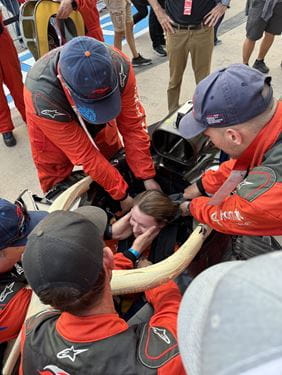 Question: What is it like to be a Motorsports Medicine Fellow at the IU School of Medicine?
Question: What is it like to be a Motorsports Medicine Fellow at the IU School of Medicine?
Answer: I’m on a new adventure every day. It’s wild. Learning from all these people who are well-known in motorsports medicine and safety across many racing series has been so wonderful. It’s nothing you can read in a textbook; it’s all hands-on experience and being a sponge, learning from all these people that have years and years of experience.
Q: How many races do you work during the year-long fellowship?
A: There are 17 races on the INDYCAR schedule, and I work at the Indianapolis Motor Speedway for other series like the USAC B39 event and Pro GT3 races. I also went to Circuit of the Americas for the Formula 1 race, and I went to Newfoundland, Canada, for Rally and IMSA races and did NHRA drag racing as well. I’m gone every weekend.
Q: What has been the highlight of your time as the motorsports medicine fellow?
A: That’s so hard to pin down. It’s honestly all so great. I’m pretty sure the Indianapolis 500 will be my best day. When I’m standing on the grid for the National Anthem and hearing “Back Home Again in Indiana,” I’m probably going to be sobbing because I’ll be so overwhelmed — it’s going to be the best thing ever.
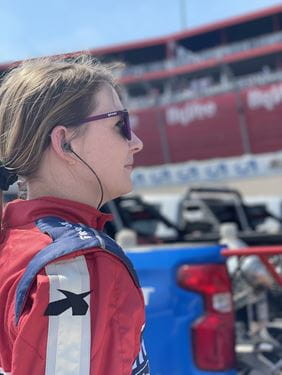 Q: What are some safety concerns for the Medical Response Team on race day?
Q: What are some safety concerns for the Medical Response Team on race day?
A: On the racetrack, there are a lot of factors that could impact our safety as physicians, so we have to be aware and pay attention while we are helping the injured person. And there’s a new element that the previous fellows did not experience. INDYCAR now has the hybrid car system, so the drivers are able to restart themselves, which they weren’t able to do in the past. The safety team and physicians are all learning how to accommodate and what to do to keep safe.
Q: What research have you done in the field of motorsports medicine?
A: Rally racing is something I’m very interested in, and I’m medical officer of two Rally races this fall. It’s street-ready cars that go into austere environments — maybe gravel roads or forest roads — and they go in one at a time, so it’s a Point A-to-Point B adventure. The safety and medical teams are the last ones following competitors. So, if there’s an injury or incident, the competitor directly behind the injured driver would be the first responder, but a lot of participants are not trained in first aid skills. I’m working on a project to create a training program, and we are going to test it at the Targa Newfoundland Rally in September.
